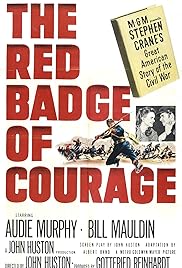RED BADGE OF COURAGE, THE
(director/writer: John Huston; screenwriters: from the book The Red Badge of Courage by Stephen Crane/Albert Band; cinematographer: Harold Rosson; editor: Ben Lewis; music: Bronislau Kaper; cast: James Whitmore (Narrator), Audie Murphy (Henry Fleming the Youth), Bill Mauldin (Tom Wilson the Loud Soldier), John Dierkes (Jim Conlin the Tall Soldier), Royal Dano (The Tattered Soldier), Arthur Hunnicutt (Bill Porter), Douglas Dick (The Lieutenant), Tim Durant (The General), Andy Devine (The Cheerful Soldier); Runtime: 69; MPAA Rating: NR; producer: Gottfried Reinhardt; MGM; 1951)
“What’s truly amazing is how good the film is despite MGM slicing it up in the re-editing process.”
Reviewed by Dennis Schwartz
What’s truly amazing is how good the film is despite MGM slicing it up in the re-editing process (a power struggle developed between honchos Louis B. Mayer and Dore Schary). According to the book “Picture” by Lilian Ross, which tells in great detail all the problems encountered by director-writer John Huston in making the film the way he wanted to, the studio was looking for a more positive and upbeat film. The Red Badge of Courage, due to Ross’ book and John Huston’s further comments in his own books, has been made a prime example of Hollywood’s philistine attitude towards the arts. It’s based on the 1894 novella by the 22-year-old Stephen Crane (who was never in a war), telling a classic war story about a frightened young soldier overcoming that fear after a battle and becoming a man.
The film stars real-life WW11 decorated hero Audie Murphy as Henry Fleming, a Civil War Union soldier from Ohio who must prove he’s not a coward in his own eyes after he deserts his regiment during their first battle together (near the Rappahannock–Chancellorsville) in the spring of 1862. He’s returned to his regiment by a Cheerful Soldier (Andy Devine), and regains his composure to fight while possessed without fear as he and his friend Tom Wilson (Bill Mauldin) lead a charge against the Rebs–with Henry carrying the flag.
Murphy is just marvelous in portraying the emotional roller coaster ride his character was going through. Many of the supporting characters also gave noteworthy performances, such as Arthur Hunnicutt as the grizzled soldier, Royal Dano as the Tattered Soldier, and Douglas Dick as the eager-beaver Lieutenant who envisions glory for himself in battle.
The film itself is visually gorgeous, as shot by Harold Rosson. It’s shot like an art film–making an intimate personal statement about the harshness of war that despite being truncated still captures the essence of Crane’s reflections. A narrator (James Whitmore) offers in a voice-over comments lifted straight out of the book as the men are pictured in the battlefield, which reminds one of those Matthew Brady Civil War pictures and gives the film a literary feel (though not in the more lyrical way Huston was gunning for). The film does a good job visually recreating the intensity and dangers of doing battle (though stopping short of covering the full impact of the bloody fighting). It also offers many realistic sensitive feeling moments like the death of the Tall Soldier (John Dierkes) and striking moments such as when the pragmatic general (Tim Durant) uses his wits to get the soldiers to feel confident so they will stay and fight.

REVIEWED ON 7/8/2005 GRADE: A-